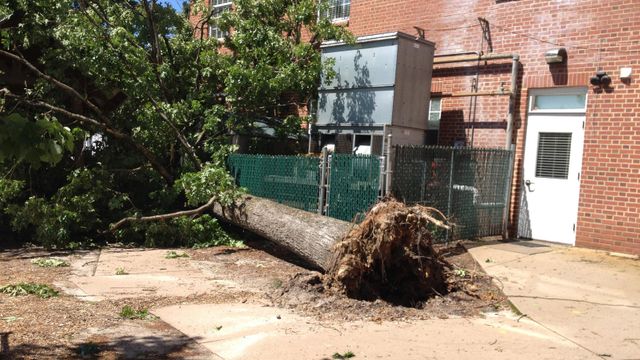Enough rain to fill Falls Lake
Whether you said it "was raining cats and dogs" or you described it as a "frog-strangler," there's no doubt we got a lot of rain Thursday.
Posted — UpdatedA lot.
A Facebook conversation with a colleague, George Bridgers at the Environmental Protection Agency and president of our local chapter of the American Meteorological Society, got me thinking – just what did all of that rain add up to? I decided to do the math.
Rainfall totals
First, we need to figure out how much rain we actually got across the area. The only truly “official” observation for the Triangle area is at RDU, but we know rainfall totals can vary widely across an area. Radar estimates provide the area coverage we need, but they are only estimates and are often well off.
That’s where CoCoRaHS comes in. It’s the Community Collaborate Rain, Hail, and Snow network, and CoCoRaHS volunteers do a great job collecting quality rainfall data and reporting it every day. Since Wake, Durham and Orange counties got the bulk of the rain, I collected all the CoCoRaHS reports from those three counties and averaged them together. I also converted to feet to make later calculations easier.
Land area
Of course, volume calculations are three-dimensional calculations: We need a length, a width and a depth – or a depth and an area. I looked up the total areas for all three counties and converted from square miles to acres.
How much water?
Now, calculating how much water fell is as simple as multiplying the amount of rain we got (depth) times the area over which it fell. I’ve provided the results in both gallons and acre-feet. Wake County alone was deluged with 67 billion gallons of water! Durham and Orange counties combined picked up more than 50 billion gallons.
Perspective
Those numbers are simply staggering, so let’s put them into a little perspective. One common reference point is an Olympic-sized swimming pool, typically 164 feet long by 82 feet wide by about 6 feet (on average) deep. Such a pool holds about 660,000 gallons of water.
By that measure, the rain that fell in Wake County could have filled more than 100,000 Olympic swimming pools. Durham’s rain could have filled another 35,000 and Orange’s another 45,000.
Who’s ready for laps?
Those numbers are still a bit big, so let’s go for bigger bodies of water. While most of that rain won’t make it directly to our local lakes and reservoirs – plants and trees will absorb some, runoff into rivers and streams will account for much more – we do rely on rains to keep our lakes full for drinking water, agricultural uses and recreation. Let’s use some local bodies of water as reference points.
Much of Wake County relies on either Jordan Lake or Falls Lake for water. Jordan Lake can hold about 15 billion gallons of water, and 67 billion gallons fell on Wake County. In other words, the amount of water that fell on Wake County alone could have filled Jordan lake, bottom-to-top, almost 4.5 times. (Note: I use Jordan Lake here for reference and for its importance as a water source for Wake County, but I should be clear to mention that most of Wake County is not in Jordan Lake’s watershed. In other words, the water that fell in Wake County, by and large, would not run off into the lake.)
Alternatively, Falls Lake is a much larger reservoir (115 billion gallon capacity), but regardless, Wake County’s rainfall could have filled it more than halfway. The rain that fell across Wake, Durham, and Orange counties could have almost filled Falls Lake from bottom to top.
Much of Durham County relies on Lake Michie for water. Durham County’s rainfall could have filled Lake Michie more than 6.5 times, were we able to harness all of that water and funnel it directly into the lake. (For obvious reasons, we would not have wanted to do that!)
Likewise, one key water source for Orange County is University Lake. It’s a smaller reservoir, and the rainfall amounts across Orange County were similarly large, so the resulting calculation shows we could have filled University Lake bottom-to-top almost 53 times with just the rain that fell inside Orange County.
So, to answer the question from before: What did all that rain add up to? A lot of water. A lot of happy lawns, lazy sprinklers and lower water bills. And hopefully, enough to keep the D-word (that would be “drought”, of course) out of our vocabulary for a long while.
• Credits
Copyright 2024 by Capitol Broadcasting Company. All rights reserved. This material may not be published, broadcast, rewritten or redistributed.






